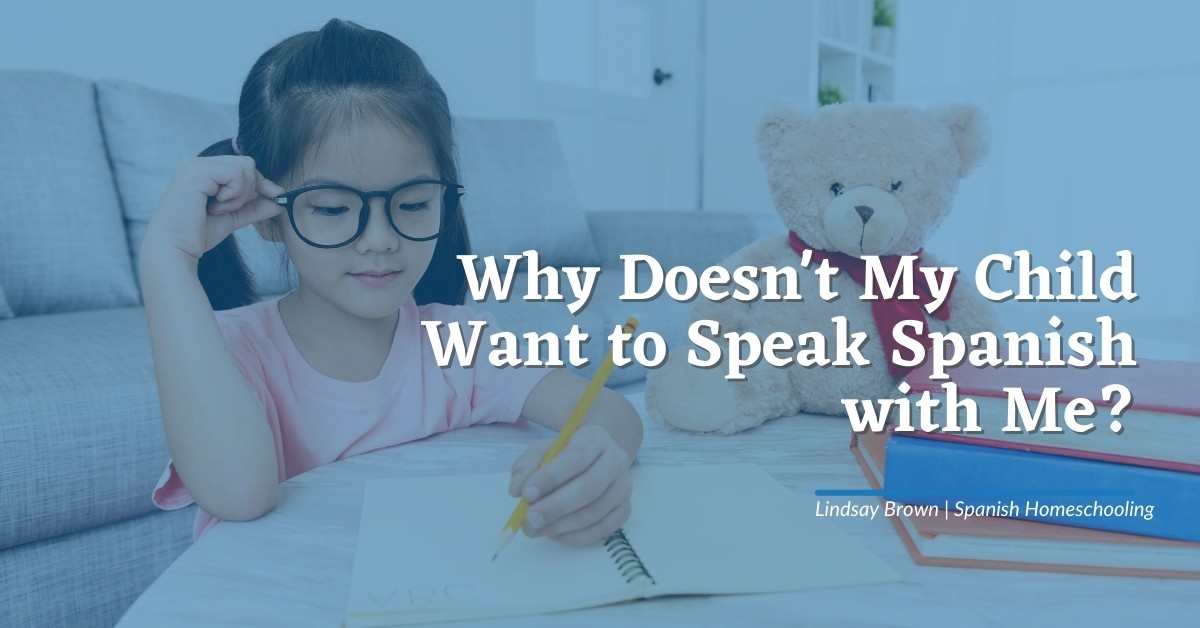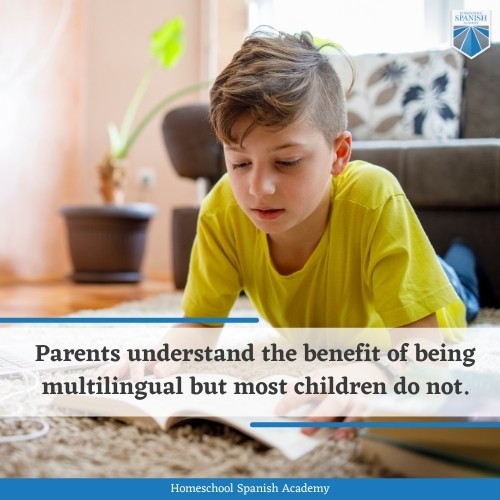
Why Doesn’t My Child Want to Speak Spanish with Me?
The rewarding challenge of raising bilingual children can take an unexpected turn into confusion. Despite your best efforts, you notice that your child refuses to speak your home language. The frustrations mount, and parents often begin to feel helpless in this situation.
But wait, the good news is up ahead! If your child used to speak Spanish at home and has stopped, this article may help you understand why.
Parents understand the benefit of being multilingual but, the truth is, most children simply do not. Even so, how can you encourage them to speak Spanish at home when it’s their native language? Let’s look at the reasons why they may refuse to speak it and how to encourage a change.
The Bilingual Child’s Dilemma
In general, the benefits of being bilingual are not clear to a child caught between two worlds. Often, they decide that the minority language—the one spoken less in their daily experience—has to go. Two prominent theories about why this happens are due to peer pressure and the breaking down of the person-language bond.
Peer Pressure
According to Barbara Abdelilah-Bauer, a French linguist, social psychologist, and founder of Café Bilingue, “[Dropping the home language] is something that often happens because children don’t want to be different from their friends at school.” In countries like the United States, for example, an average of only 2 out 10 of children are bilingual. In other words, the minority of children do not speak English at home. Unfortunately, this may contribute to the peer pressure they feel to conform to speaking English all the time.
Person-Language Bond
The person-language bond refers to a strong psycho-emotional connection the child makes to a caretaker. It also affects the language they use to speak to one another.
Let’s look at an example. A mother lives in an English-speaking community and chooses to speak only Spanish to her son. As he grows, he realizes that he speaks Spanish with mom and English with everyone else. This strengthens his person-language bond with her and he will likely refuse to speak English with her. If the mother begins to speak to him in English as well, it will quickly break down their strong language association. This will erode his need to speak Spanish to his mother and lead to him speaking to her in English.
“Children use the easiest strategy when it comes to languages. When they see that you understand and talk other languages that are more important at the moment (social environment, school, and friends) they will prefer those dominant languages,” says Ute Limacher-Riebold of ExpatSinceBirth.

What are other possible reasons they are not speaking Spanish?
What might be some other reasons that your child is not speaking Spanish at home?
Discomfort
Make sure your child doesn’t feel pressured to speak Spanish in certain situations. This can lead to associating a sense of embarrassment with the language. Also, kids tend to notice if a parent feels uncomfortable speaking a certain language. They will eventually end up feeling the same way toward it.
Few Language Resources
Does your child have a rich collection of books, DVDs, games, and other language-heavy types of media? If not, then it’s time to start gathering as many Spanish-speaking resources as possible. Create a space that grabs your child’s attention.
Spanish is Being Learned, Not Lived
Language must be relevant and meaningful for the child in order for them to use it. Otherwise, the language may lose its purpose and appeal.
Not Enough Exposure
How many hours a week is your child exposed to Spanish-speaking situations? If less than 30% of their time is spent in this kind of environment, you may want to consider adding more “living resources” (such as people and family members who only speak Spanish) to their daily life.
The Parent Speaks the Community Language More Often
How often do you find yourself speaking Spanish with your child or with the people in your life? Do you notice that you speak more frequently in the majority or community language? When another language is more dominant, it can affect your child’s idea of how important it is to speak Spanish.
Dormant or Passive Bilingualism?
Even if a child chooses to stop speaking Spanish, the good news is that they don’t typically lose their bilingual ability (unless they go years without practice). To most effectively encourage a change in your child’s language choice, it’s important to understand whether your child is dormant or passive when it comes to Spanish fluency.
Sometimes, a person will go into a mode called dormant bilingualism, where, despite knowing two languages or more, they choose to interact with the world in only one language. Swiss psycholinguist François Grosjean says that this could be due to a “major life change such as immigration, the loss of a close family member, a separation, a change of jobs, or simply growing up and leaving one’s language community.” In this case, they would still have a strong fluency level in Spanish, but they no longer choose to speak it while they adapt to their new circumstances.
Passive bilingualism refers to a type of speaker who was exposed to a language since birth and has a native-like comprehension of it, but who did not develop an active command of speaking the language. In this case, they would need educational reinforcements and confidence-building to help them establish an ability to speak Spanish (not just understand it).
How to Encourage the Use of Home Language
Understanding whether your child is a dormant or passive bilingual will help you choose the best fit! Here are some ways we can encourage usage of the home language:
- Seek out Spanish playgroups that encourage your child to speak in the language.
- Foster settings where your child will no longer have the choice of not using Spanish by exposure to babysitters, tutors, family members, and other children with whom Spanish is the only way to communicate. You can also invite home-stay guests or have them home-stay with a family that only speaks Spanish.
- Actively promote a greater level of exposure to Spanish each day. Try to aim for 25 hours of active listening and speaking time each week with at least 15 minutes a day reading (and writing, if possible).
- Focus on making a rich home library with Spanish books and read with your child every night. Make use of effective reading strategies.
- Engage in lots of conversation by telling stories or folklore that you may know, talking about interesting events from your life, and sharing jokes and riddles.
- Introduce your child to Spanish music, computer games, TV shows, and other media that are fun and entertaining.
- Build up a fun collection of Spanish games: board games, card games, word games, and storytelling games.
- Balance your child’s Spanish experience with providing a need to speak it and maintaining constant exposure to it.
- Limit the amount of time you spend speaking to your child in any language other than Spanish.
- When you ask your child questions, offer up different choices or options instead of expecting a simple yes or no. This gives you the chance to model a richer, fuller use of the language.
- at Homeschool Spanish Academy,
Benefits of Bilingualism
While it is no easy task to get your bilingual child back on track, it is possible to do! We hope that with this article you have learned more about why your child may no longer be speaking Spanish and how to inspire them to change.
If you would like to encourage your child to practice speaking with a native Spanish-speaking teacher from Guatemala, enroll them in an online Spanish class at Homeschool Spanish Academy! They are guaranteed to speak Spanish after the first class.

Want more resources for teaching Spanish at home? Check these out!
- How to Create a Daily Homeschooling Routine Using Spanish Fluency Games for Kids
- How to Help Your Child Speak Spanish with Confidence (Without Feeling Embarrassed!)
- The Best Spanish Learning Podcasts for Kids
- Spanish for Middle Schoolers: The Perfect Age to Start (Here’s Why!)
- Raising a Bilingual Child: 10 Must-Have Resources Every Parent Needs
- 5 Inspiring Middle Schoolers Who Mastered Spanish—Their Secrets to Success
- The Secret to Raising a Bilingual Child—Without Overwhelm
- One-on-One vs. Group Spanish Lessons: Which Is Best for Your Preschooler?
- Top-Rated Accredited Online Spanish Classes for Kids - February 22, 2023
- 6 Compelling Reasons Why Your School Should Outsource Spanish Class - February 3, 2023
- 20 Free Spanish Books, Novels, and Stories in PDF and Printables - January 25, 2023




